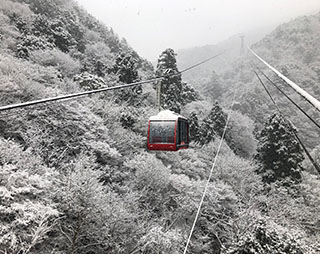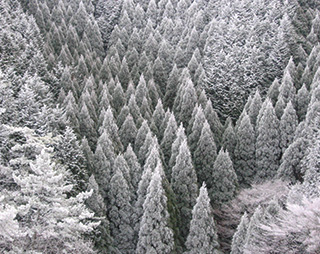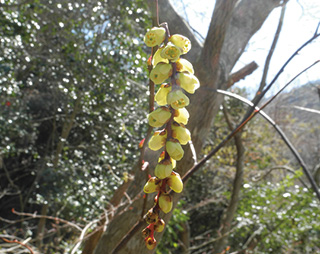Service Information
Maya Cable
Regular closing day
Maya Ropeway
Regular closing day
Rokko-Arima Ropeway
Out of service due to the strong wind.
Ropeway highlights
The Rokko-Arima Ropeway allows passengers to travel between the Mt. Rokko mountaintop area and the Arima Onsen hot springs via a 12 minute ride. Visitors can enjoy the dynamic natural sights, as the scenery drastically changes throughout the four seasons.
Springtime provides visitors with a scene abundant with vivid greenery, while in summertime visitors often come to escape the heat. During autumn, the changing color of the leaves are reminiscent of the beautiful colors used in Nishiki-e paintings, while in wintertime, the frozen dew on the trees makes for a somber yet peaceful scene. Visitors are sure to enjoy the magnificent scenery along the ropeway line.
Toward the east of the ropeway, passengers can view the Rokko mountain range that stands at an elevation of 931m, against the backdrop of the blue sky.
To the west, beyond the valley, passengers can see the Seto Inland Sea off in the distance. Although it is quite rare to spot it, during times of good weather, it is even possible to spot the Ieshima islands, as well as Shodo Island which is located off to the left.
We highly encourage all visitors to ride the ropeway if even just to enjoy the one-of-a-kind view.
Gradation of greenery during early to late springtime
-
![[Rokko-Arima Ropeway during springtime]](/img/rokko/miryoku/img_rokko_miryoku_01.jpg)
[Rokko-Arima Ropeway during springtime]
-
![[Kousa dogwood trees and gondola shadow]](/img/rokko/miryoku/img_rokko_miryoku_02.jpg)
[Kousa dogwood trees and gondola shadow]
-
![[Swida macrophylla trees along the ropeway line]](/img/rokko/miryoku/img_rokko_miryoku_03.jpg)
[Swida macrophylla trees along the ropeway line]
At this time of year, “cerasus jamasakura” cherry blossom trees and “magnolia salicifolia” trees particularly stand out.
“Rhododendron farrerae” flowers accentuate the mountain scenery with their deep pink petals.
In March, the plant life begins to re-emerge, with young leaves beginning to sprout, and the tips of the tree branches taking on a warm pink hue. As the gondola departs Arima Onsen Station, passengers can enjoy the scenery, which is dotted with pale yellow flowers beginning to bloom, amid the backdrop of wilted trees and plants. The appearance of these “stachyurus praecox” flowers can be likened to “kanzashi” (Japanese ornamental hairpins for women) in the way they hang from the branches. Drooping vertically downwards from the tall branches, these flowers dot the scenery, reminding visitors that spring is approaching, and in a matter of time, the verdant mountain scenery will soon return.
After mid-April, the pale to deep yellow leaves of the newly born plant life in the mountains adds color to the green gradient of the scenery. The vibrant greenery of the forest at this time of year provides three-dimensional depth to the mountain’s appearance, and the multitude of trees can be likened in appearance to an expansive field of “broccoli.”
In May, the forest surrounding the Rokko-Arima Ropeway line enters its most vividly verdant season. The echo of wild birds chirping resonates through Mt. Rokko, and visitors listening carefully can hear the soft rustling of leaves of the newborn plant-life. During this season, the temperature around Rokko Sancho Station is quite pleasant. The “broccoli-like” appearance of the greenery along the ropeway line gradually deepens and takes on a more subdued green hue as time passes. Visitors are also treated to the sight of “kousa dogwood” trees, with their white flowers that bloom upward to the sky, adding a subtle touch to the refreshingly verdant scenery.
Enjoying the cool breeze and sounds of nature during summertime
-
![[Hydrangea macrophylla shrubs and Rokko-Arima Ropeway]](/img/rokko/miryoku/img_rokko_miryoku_04.jpg)
[Hydrangea macrophylla shrubs and Rokko-Arima Ropeway]
-
![[Summer blue sky and ropeway]](/img/rokko/miryoku/img_rokko_miryoku_05.jpg?2412)
[Summer blue sky and ropeway]
-
![[Night view of Arima from the train window]](/img/rokko/miryoku/img_rokko_miryoku_06.jpg?2412)
[Night view of Arima from the train window]
In June, the greenery matures and takes on a deeper green hue. As the gondola passes over Yubune-dani, visitors can view the large swaths of “kousa dogwood” trees and their clusters of white flowers at the bottom of the valley.
In mid-June, the “swida macrophylla” flowers begin blooming along the ropeway line, with their yellowish-white flowers dotting the landscape.
During the rainy season, visitors come to enjoy a spectacular aerial ride as they travel above the clouds far above the city below.
In July, the temperature near the mountain top ranges from about 19 to 21 degrees Celsius. 6-7 degree cooler than temperatures in the city, summertime is quite pleasant on the mountaintop. From around 3PM, as the sun slowly begins to set in the west, until 10AM the following day, visitors can hear the distinct chirping of the tanna japonensis evening cicada.
Starting in August, the ropeway provides extended nighttime services, allowing visitors to enjoy the “10 million dollar night-view.” The aerial ride provides passengers with a wonderful night-view of the Arima Onsen area.
Enjoying a stunning aerial view much like a “natural Nishiki-e painting” during autumn
-
![[Aerial ride amid the autumn leaves]](/img/rokko/miryoku/img_rokko_miryoku_07.jpg)
[Aerial ride amid the autumn leaves]
-
![[View of the autumn mountain scenery from the Rokko-Arima Ropeway]](/img/rokko/miryoku/img_rokko_miryoku_08.jpg)
[View of the autumn mountain scenery from the Rokko-Arima Ropeway]
-
![[Autumn leaves in the Arima area spreading out below]](/img/rokko/miryoku/img_rokko_miryoku_09.jpg?2412)
[Autumn leaves in the Arima area spreading out below]
Once September arrives, the area becomes less crowded than in summer, as the weather gradually becomes cooler. During this season, fortunate visitors may be able to see the “sea of clouds” that spreads out over the Tamba Highlands, located beyond the magnificent Yubune-dani valley, from inside the gondola. The “artistic” beauty of the clouds in the sky provides a breathtaking scene.
In mid-October, the leaves around Rokko Sancho Station (Rokko Garden Terrace・GREENIA mae) begin to change color.
The “enkianthus perulatus” leaves at Rokko Sancho Station (Rokko Garden Terrace・GREENIA mae) turn deep red in color, and the cosmos plants, although not tightly clustered together, slowly begin to take on a whitish and pinkish hue.
In November, passengers inside the gondola can enjoy a panoramic view with beauty that rivals that of a Nishiki-e painting. After leaving from Arima Onsen Station, toward the west, passengers can see the maple leaves which bring a deep red hue to the valley scenery. While passengers enjoy the view, the gondola continues its steep 29 degree ascent.
As the gondola rises 140m in the air, passengers can marvel in a panoramic view of the peak of Mt. Rokko (standing 931m), as well as Mt. Yubune-dani (801m) and Mt. Nishi-otafuku (878m), which are spread out along an area that spans roughly 2km.
The somber monotone scenery of winter
-

[Rokko-Arima Ropeway during winter]
-

[Hard rime (caused by freezing fog) viewed from the Rokko-Arima Ropeway]
-

[Stachyurus praecox trees near Arima Onsen Station]
In December, after the autumn leaves have fallen, the area takes on a more solemn tone. During this season, the breathtaking sunsets on the backdrop of the Seto Inland Sea are a sight to behold. The crimson-colored sky and the shimmering water provide visitors with a most fantastic scene.
In early winter, the air on the mountaintop becomes more crisp. Visitors during this time of year can enjoy a truly unique Christmas season experience.
In January, the Rokko mountaintop area typically records about 15-20cm of snowfall, creating a surreal yet peaceful monotone atmosphere. Even in such harsh weather, there still exist flowers that bloom along the ropeway line.
To the east of Arima Onsen Station, the hard, glossy petals of the “camellia japonica” can be found. As soon as the gondola departs Arima Onsen Station, passengers can listen to the roaring of the Tsutsumi-ga-taki waterfall located right below the gondola. As it is surrounded by trees, this waterfall is not visible from late spring to autumn, but visitors during this time of year can view it from 30m above as they pass over it in the gondola. Visitors can view the legendary waterfall from the gondola, which is renowned for how the water pours directly downwards from a height of 8m.
In February, visitors can enjoy the splendor of the hard rime formations that can be found on the plant life around the Rokko Sancho Station (Rokko Garden Terrace・GREENIA mae) area. After the first day of spring, visitors can come enjoy the surreal scenery of the frozen plant life sparkling in the sun’s light. Hard rime forms when the water vapor in fogs and clouds freeze, attaching itself to trees and plants. The formation of hard rime on the trees around the Rokko Sancho Station (Rokko Garden Terrace・GREENIA mae) area is a rare phenomenon, and only occurs when temperatures reach negative 5 degrees Celsius or below.





